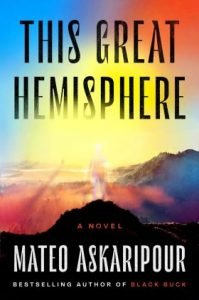This Great Hemisphere by Mateo Askaripour (book review).
Sweetmint has followed the rules of the Northwestern Hemisphere all her life. As a young, invisible woman, she must adhere to numerous rules. The dominant population, the visible, the DPs, keep track of the invisible population with collars, paint, and poverty. Her obedience has now paid off. After years of effort, Sweetmint has achieved an unheard of honor for the invisible, an apprenticeship with the Hemisphere’s foremost inventor and genius. The murder of the Chief Executive of the Hemisphere, with her long-lost brother as the prime suspect, could undo all of Sweetmint’s hard work. Sweetmint must find the beloved brother she hasn’t seen in decades, while the manhunt for him upends the invisible community, and the election for the first new ruler in decades comes to a violent head.
Upon reading this novel, ‘This Great Hemisphere’, it becomes evident that similarities exist between the contemporary world and the fictional realm, where a physically distinct group of humans succumbs to another. The prologue, set in the extreme near future of 2028, 500 years before the rest of the story, highlights and underlines this. Although I believe speculative fiction can provoke the reader to reexamine their own reality, I typically dislike novels that prioritize the moral lesson over the narrative. Books that shout, ‘Hey, look! Books that loudly proclaim ‘Hey look! There’s a moral!’ tend to overshadow everything else. In Mateo Askaripour’s ‘This Great Hemisphere,’ the world-building is exceptional, providing breathtaking glimpses into an ecologically devastated world under a government reminiscent of Stalin’s. The struggle of the invisibles, who are almost-but-not-quite slaves, is undoubtedly the main focus, but, similar to Stalin’s Russia, everyone lives in constant fear. The invisibles undoubtedly face the worst, while the few visible characters live in constant fear.
It became too bleak halfway through this novel, so I stopped. The novel relentlessly presented chapter after chapter with reasons why the world is inherently flawed. One scene in the house of parliament appears to have no specific purpose, yet it powerfully conveys the violent, sexualized anger that the visible ruling class harbors towards the invisible. The argument has already been reiterated numerous times. The rules of parliament actually include this instance, which makes it somewhat unique. But not really.
The life story and revolution plots take a backseat due to a constant stream of negative events and poor decisions. By the time the big reveal turned up, I just didn’t care. I’d almost forgotten that the story had begun with a murder, so I didn’t really mind who had done it.
Every writer has to focus on the story they want to share in the giant world they’ve created. Askaripour wants to share a big story; I just wish they had chosen to share it through Sweetmint.
If this is going to be a trilogy (it does have that feel), I would only read more if everything got thrown together and came out a bit more balanced.
‘This Great Hemisphere’ theoretically follows Candace/Sweetmint’s story as she tries to find her brother, but it trails away on side quests to build the world.
‘This Great Hemisphere’ is neither a light read nor a book to binge on. The book is well-written, yet it is excessively bleak. If you enjoyed Naomi Alderman’s ‘The Power’ or Margaret Atwood’s ‘The Handmaid’s Tale,’ this might be the new release for you. It wasn’t for me, but I will keep an eye out for future work by the author.
LK Richardson
July 2024
(pub: Dutton/Penguin, 2024. 432 page hardback. Price: $29.00 (US), £25.99 (UK), ISBN: 978-0-59347-234-7
check out website: www.penguinrandomhouse.com/books/713716/this-great-hemisphere-by-mateo-askaripour/9780593472347/


